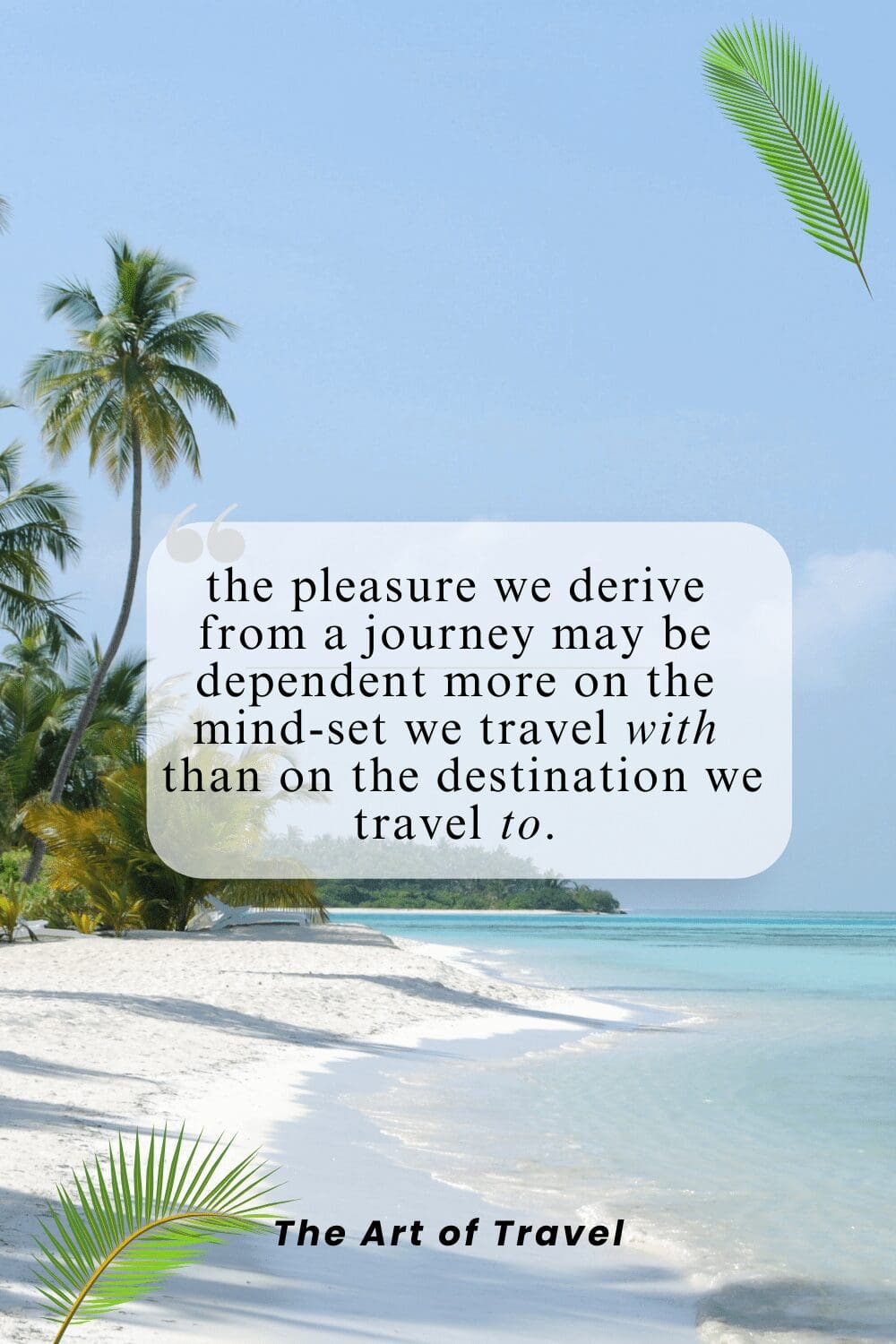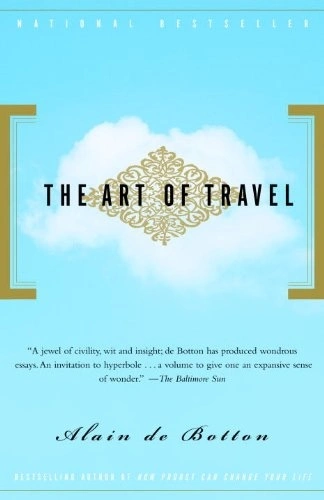I’ve always wanted to travel. One of the most alluring aspects of life is getting away somewhere and seeing the never before seen. But travel is more than just the destination; it’s also what we bring to that place. Travel isn’t just packing your bags, showing up, eating the food, and seeing the sights. Travel, ultimately, is an exploration and discovery of ourselves, and that’s one of the many elements of travel that Alain de Botton delves into in his book, The Art of Travel.
I read The Art of Travel on a train to New Orleans in early December. I had plenty of time to read it given the fact that the train was held up by thieves attempting to steal TVs and other pricey electronics that were being shipped in the boxcars due to the upcoming holiday season. While that may sound dramatic, I never saw the thieves and was in no way affected by their attempted escapade other than the fact we were stopped for hours as the event unfolded. Hunger and boredom drove me to visit the dining car, which can best be described as a Waffle House on wheels.
As I sat in the narrow dingy yellow booth drinking stale coffee, I stared out into the stalled night and thought about how I had always envisioned train travel. This wasn’t it. Still, it was an interesting experience, and I had a new travel story to tell.
In Chapter 1 of The Art of Travel, Alain de Botton begins with perhaps the most exciting part of travel: the anticipation. Knowing a trip or vacation is on the horizon gives us something to look forward to, something to build up in our minds and explore even before we step out the door. I read a study once about brain activity when someone is given a present. The peak happiness occurred in the anticipation of opening the present, not the gift itself.
We romanticize the future, but sometimes stumble when that future is realized and becomes our present. Luggage gets lost, your back is stiff from the flight, the hotel is not as nice as the pictures made out, the exotic meal you ate last night kept you up all night, tiredness sets in, you snap at your travel companion(s), all while trying to make your “anticipation high” match the physical reality of being in your dreamed-of destination.
There is an art to travel, to making the most of the places you go, but there’s also happiness in learning how to make the most of the place you call home.
16 Quotes from The Art of Travel by Alain de Botton
Chapter I: On Anticipation
1. “If our lives are dominated by a search for happiness, then perhaps few activities reveal as much about the dynamics of this quest–in all its ardour and paradoxes–than our travels.” The Art of Travel
2. “A momentous but until then overlooked fact was making itself apparent: I had inadvertently brought myself with me to the island.” The Art of Travel
3. “It is unfortunately hard to recall our quasi-permanent concern with the future, for on our return from a place, perhaps the first thing to disappear from memory is just how much of the past we spent dwelling on what was to come—how much of it, that is, we spent somewhere other than where we were. There is a purity both in the remembered and in the anticipated visions of a place: in each instance it is the place itself that is allowed to stand out.” The Art of Travel
Chapter II: On Travelling Places
4. “The destination was not really the point. The true desire was to get away—to go, as he concluded, ‘anywhere! anywhere! so long as it is out of the world!’ The Art of Travel
5. “…the plane a symbol of worldliness, carrying within itself a trace of all the lands it has crossed, its eternal mobility offering an imaginative counterweight to feelings of stagnation and confinement.” The Art of Travel
6. “The constant calls of the screens, some accompanied by the impatient pulsing of a cursor, suggest with what ease our seemingly entrenched lives might be altered were we simply to walk down a corridor and onto a craft that in a few hours would land us in a place of which we had no memories and where no one knew our name. How pleasant to hold in mind through the crevasses of our moods, at three in the afternoon, when lassitude and despair threaten, that there is always a plane taking off for somewhere, for Baudelaire’s ‘anywhere! anywhere!’: Trieste, Zurich, Paris.” The Art of Travel
7. “There is psychological pleasure in this takeoff, too, for the swiftness of the plane’s ascent is an exemplary symbol of transformation. The display of power can inspire us to imagine analogous, decisive shifts in our own lives, to imagine that we, too, might one day surge above much that now looms over us.” The Art of Travel
8. “Journeys are the midwives of thought. Few places are more conducive to internal conversations than moving planes, ships or trains. There is an almost quaint correlation between what is before our eyes and the thoughts we are able to have in our heads: large thoughts at times requiring large views, and new thoughts, new places. Introspective reflections that might otherwise be liable to stall are helped along by the flow of the landscape.” The Art of Travel
9. “It is not necessarily at home that we best encounter our true selves. The furniture insists that we cannot change because it does not; the domestic setting keeps us tethered to the person we are in ordinary life, who may not be who we essentially are.” The Art of Travel
10. “Hotel rooms offer us a similar opportunity to escape our habits of mind.” The Art of Travel
Chapter III: On the Exotic
11. “I stopped by a red front door and felt an intense longing to spend the rest of my life there. Above me, on the second floor, I could see an apartment with three large windows and no curtains. The walls were painted white and decorated with a single large painting covered with small blue and red dots. There was an oaken desk against a wall, a large bookshelf and an armchair. I wanted the life that this space implied. I wanted a bicycle; I wanted to put my key in that red front door every evening. I wanted to stand by the curtainless window at dusk, looking out at the identical apartment opposite, and then snack my way through an erwentsoep met roggebrood en spek before retiring to read in bed in a white room with white sheets.” The Art of Travel
12. “What we find exotic abroad may be what we hunger for in vain at home.” The Art of Travel
Chapter IV: On Curiosity
13. “A danger of travel is that we may see things at the wrong time, before we have had an opportunity to build up the necessary receptivity, so that new information is as useless and fugitive as necklace beads without a connecting chain.” The Art of Travel
Chapter VI: On the Sublime
14. “There are few emotions about places for which adequate single words exist; we are forced instead to make awkward piles of words to convey what we feel as we watch the light fade on an early-autumn evening, or when we encounter a pool of perfectly still water in a clearing.” The Art of Travel
15. “A landscape could arouse the sublime only when it suggested power—a power greater than that of humans, and threatening to them. Sublime places embodied a defiance to man’s will.” The Art of Travel
Chapter IX: On Habit
16. “…the pleasure we derive from a journey may be dependent more on the mind-set we travel with than on the destination we travel to.” The Art of Travel

Related Posts:
